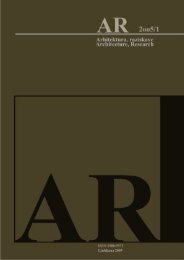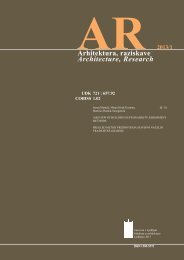AR 2010/1 - Fakulteta za arhitekturo - Univerza v Ljubljani
AR 2010/1 - Fakulteta za arhitekturo - Univerza v Ljubljani
AR 2010/1 - Fakulteta za arhitekturo - Univerza v Ljubljani
You also want an ePaper? Increase the reach of your titles
YUMPU automatically turns print PDFs into web optimized ePapers that Google loves.
Kaja Pogačar, Metka Sitar<br />
TIPOLOGIJA ČEZMEJNIH URBANIH OBMOČIJ<br />
<strong>AR</strong> <strong>2010</strong>/1<br />
Conclusion<br />
A selection of urban types as specific urban formations that have<br />
developed in the areas across the national borders within the<br />
framework of EU was presented. The aim was to point out the<br />
new development dynamics, which has attracted the attention of<br />
numerous scholars and practitioners. It has been shown that the<br />
examined cross-border types are considered atypical in terms<br />
of their administrative, technical, legal, financial, and cultural<br />
dysfunctions, and are often more complex compared to types<br />
found elsewhere within countries. In the case of cross-border<br />
areas, EU policies primarily represent the tendency to find a<br />
balance between competition and cooperation. Thus, with<br />
respect to existing cross-border initiatives, i.e. various urban<br />
programmes, plans, and actions, additional analysis of the<br />
possibilities of active incorporation into functional urban<br />
systems must be recommended.<br />
Taking into account the perspectives of urban development<br />
in Slovenian border regions, it is the fact that the most lively<br />
cross-border types are in most cases located on borders in<br />
Western Europe. Their prosperity is mostly supported by the<br />
specific conditions of intensive daily migration, despite the<br />
organisational difficulties caused by the complexity of the<br />
changed circumstances of daily life. On the other hand, certain<br />
types, such as border crossings, are situated in marginal border<br />
areas. During recent decades, they have been transformed into<br />
completely non-distinctive urban sites in terms of economic,<br />
social, and cultural life. In future perspectives, these areas, also<br />
in the Slovenian context, might experience non-linear leaps of<br />
development, especially under the influence of foreign capital,<br />
knowledge and culture.<br />
16

















